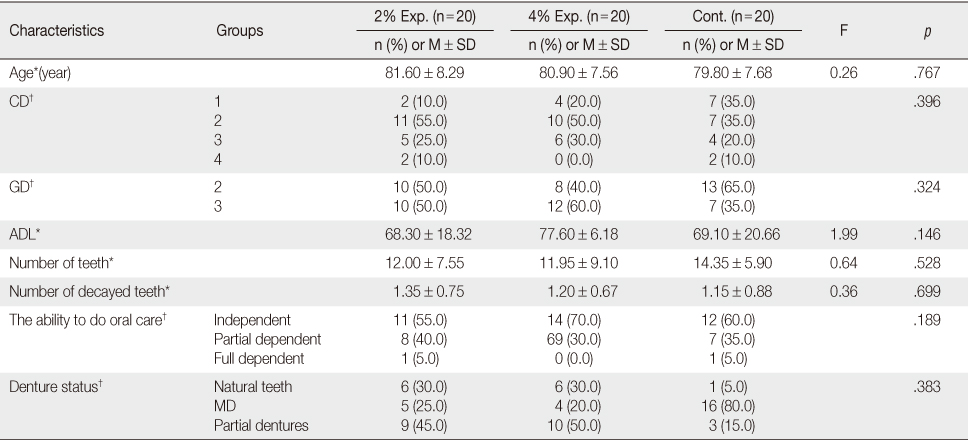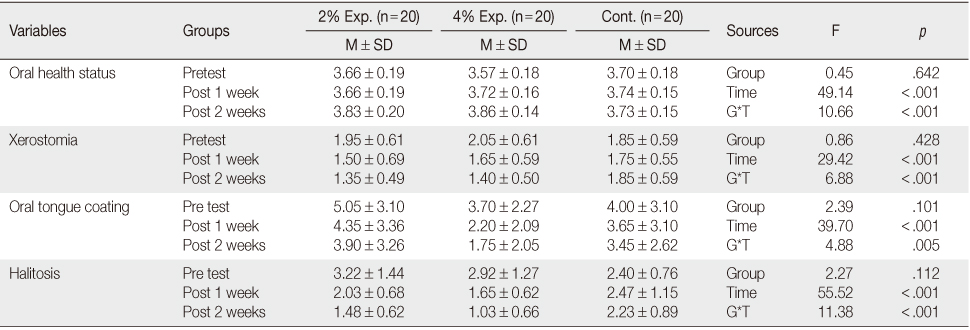Articles
- Page Path
- HOME > J Korean Acad Nurs > Volume 44(1); 2014 > Article
-
Original Article
- Effects of 4% Hypertonic Saline Solution Mouthwash on Oral Health of Elders in Long Term Care Facilities
- Ju Ok Kim, Nam Cho Kim
-
Journal of Korean Academy of Nursing 2014;44(1):13-20.
DOI: https://doi.org/10.4040/jkan.2014.44.1.13
Published online: February 28, 2014
1Department of Nursing, Bucheon University, Bucheon, Korea.
2College of Nursing, The Catholic University of Korea, Seoul, Korea.
- Address reprint requests to: Kim, Nam Cho. College of Nursing, The Catholic University of Korea, 222 Banpo-daero, Seocho-gu, Seoul 137-701, Korea. Tel: +82-2-2258-7405, Fax: +82-2-2258-7772, kncpjo@catholic.ac.kr
© 2014 Korean Society of Nursing Science
This is an Open Access article distributed under the terms of the Creative Commons Attribution NoDerivs License. (http://creativecommons.org/licenses/by-nd/4.0/) If the original work is properly cited and retained without any modification or reproduction, it can be used and re-distributed in any format and medium.
Abstract
-
Purpose
- This study was done to examine the effects of 4% hypertonic saline solution mouthwash and tooth brushing education on the oral health of elders living in long term care facilities.
-
Methods
- In this quasi-experimental study, the participants were assigned to a 2% experimental group (n=20), a 4% experimental group (n=20), and a control group (n=20). Data were analyzed using ANOVA, repeated measures ANOVA, Fisher exact test, Chi-square test, Kruskal-Wallis test and multiple response analysis with the SAS program.
-
Results
- Regular tooth brushing and use of 4% hypertonic saline solution mouthwash by elders provided better oral health by decreasing xerostomia, oral tongue plaque, halitosis, and the number of oral bacteria.
-
Conclusion
- The results indicate that regular tooth brushing with continuous 4% hypertonic saline solution mouth washing education promotes oral health for elders in long term care facilities, thus the dental care described in this study is recommended for elders in long term facilities.
This article is a condensed form of the first author's doctoral thesis from The Catholic University of Korea.
- 1. Petersen PE, Yamamoto T. Improving the oral health of older people: The approach of the WHO Global Oral Health Programme. Community Dent Oral Epidemiol. 2005;33(2):81–92. http://dx.doi.org/10.1111/j.1600-0528.2004.00219.xArticlePubMed
- 2. Shenkin JD, Baum BJ. Oral health and the role of the geriatrician. J Am Geriatr Soc. 2001;49(2):229–230.ArticlePubMed
- 3. Petersen PE. Global policy for improvement of oral health in the 21st century-implications to oral health research of World Health Assembly 2007, World Health Organization. Community Dent Oral Epidemiol. 2009;37(1):1–8. http://dx.doi.org/10.1111/j.1600-0528.2008.00448.xArticlePubMed
- 4. Vanobbergen JN, De Visschere LM. Factors contributing to the variation in oral hygiene practices and facilities in long-term care institutions for the elderly. Community Dent Health. 2005;22(4):260–265.PubMed
- 5. Chalmers J, Johnson V, Tang JH, Titler MG. Evidence-based protocol: Oral hygiene care for functionally dependent and cognitively impaired older adults. J Gerontol Nurs. 2004;30(11):5–12.Article
- 6. Frenkel H, Harvey I, Newcombe RG. Improving oral health in institutionalised elderly people by educating caregivers: A randomised controlled trial. Community Dent Oral Epidemiol. 2001;29(4):289–297.ArticlePubMedPDF
- 7. McDowell S. Are we using too much Betadine? RN. 1991;54(7):43–45.
- 8. Park MS. The effect of oral health care education for care providers in a long-term care facility [dissertation]. Seoul, Seoul National University. 2010.
- 9. Park HJ, Shin HS. The effects of mouth care with sterile normal saline on chemotherapy-induced stomatits. J Nurs Acad Soc. 1995;25(1):5–16.ArticlePDF
- 10. Carl W. Oral complications in cancer patients. Am Fam Physician. 1983;27(2):161–170.
- 11. Kim CY, Chung SC, Sohn WS. Comparison of the anti-plaque and anti-inflammatory effect of the dentifrices contatining NaCl and bamboo salt. J Korean Acad Dent Health. 1991;15(2):269–280.
- 12. Lee S. The effect of the dentifrice included bamboo salt, rosin etc on oral environment [dissertation]. Seoul, Kyung Hee University. 2004.
- 13. Andrius OK. Histologic changes of gingiva of rats after irrigation with sea water. J Dent Res. 1966;45(4):1224. http://dx.doi.org/10.1177/00220345660450043401ArticlePubMedPDF
- 14. Satdhabudha A, Poachanukoon O. Efficacy of buffered hypertonic saline nasal irrigation in children with symptomatic allergic rhinitis: A randomized double-blind study. Int J Pediatr Otorhinolaryngol. 2012;76(4):583–588. http://dx.doi.org/10.1016/j.ijporl.2012.01.022ArticlePubMed
- 15. Park MS. The effect of oral health care education for care providers in a long-term care facility [dissertation]. Seoul, Seoul National University. 2010.
- 16. Nieweg R, van Tinteren H, Poelhuis EK, Abraham-Inpijn L. Nursing care for oral complications associated with chemotherapy. A survey among members of the Dutch Oncology Nursing Society. Cancer Nurs. 1992;15(5):313–321.PubMed
- 17. Beck S. Impact of a systematic oral care protocol on stomatitis after chemotherapy. Cancer Nurs. 1979;2(3):185–199.ArticlePubMed
- 18. Park YJ, Hong MS. The influence of saline and betadine solution for gargle in the leukemic patients receiving chemotherapy. Chonnam J Nurs Sci. 1996;1(1):41–58.
- 19. Chung SH. The effect of essential oil mouthrinse on oral health of the community indwelling elderly [dissertation]. Seoul, The Catholic University. 2005.
- 20. Winkel EG, Roldán S, Van Winkelhoff AJ, Herrera D, Sanz M. Clinical effects of a new mouthrinse containing chlorhexidine, cetylpyridinium chloride and zinc-lactate on oral halitosis. A dual-center, double-blind placebo-controlled study. J Clin Periodontol. 2003;30(4):300–306.PubMed
- 21. Süslü N, Bajin MD, Süslü AE. Effects of buffered 2.3%, buffered 0.9%, and non-buffered 0.9% irrigation solutions on nasal mucosa after septoplasty. Eur Arch Otorhinolaryngol. 2009;266(5):685–689. http://dx.doi.org/10.1007/s00405-008-0807-5ArticlePubMedPDF
- 22. Lee KN, Tae YS. The effects of mouth care on oral discomfort of cancer patient undergoing chemotherapy. J Korean Acad Adult Nurs. 1999;11(4):785–795.
- 23. Ship JA. Diagnosing, managing, and preventing salivary gland disorders. Oral Dis. 2002;8(2):77–89.ArticlePubMedPDF
- 24. Epstein JB, Polsky B. Oropharyngeal candidiasis: A review of its clinical spectrum and current therapies. Clin Ther. 1998;20(1):40–57.ArticlePubMed
- 25. Lee MK, Kim HR, Ro BI. Identification of candida species by analysis of rRNA spacer regions. Korean J Med Mycol. 2006;11(1):13–18.
- 26. Kim BJ, Gong SH, Kim YH, Seol ME, Lee SG, Lee EM, et al. Care of cancer patients: Symptom management. 2nd ed. Seoul: Hyunmoon; 2001.
- 27. Wolff LF, Pihlstrom BL, Bakdash MB, Schaffer EM, Jensen JR, Aeppli DM, et al. Salt and peroxide compared with conventional oral hygiene. II. Microbial results. J Periodontol. 1987;58(5):301–307. http://dx.doi.org/10.1902/jop.1987.58.5.301ArticlePubMed
- 28. Sauvaget E, David M, Bresson V, Retornaz K, Bosdure E, Dubus JC. Nebulized hypertonic saline and acute viral bronchiolitis in infants: Current aspects. Arch Pediatr. 2012;19(6):635–641. http://dx.doi.org/10.1016/j.arcped.2012.03.018PubMed
- 29. Keojampa BK, Nguyen MH, Ryan MW. Effects of buffered saline solution on nasal mucociliary clearance and nasal airway patency. Otolaryngol Head Neck Surg. 2004;131(5):679–682. http://dx.doi.org/10.1016/j.otohns.2004.05.026ArticlePubMedPDF
REFERENCES
Figure & Data
REFERENCES
Citations

- Surface characteristics and ion leaching of 17-4 precipitation hardening stainless steel orthodontic brackets exposed to salt water and fluoride-based oral rinses
Durgesh Bangalore, Raghad Alhassoun, Samer M. Alaqeel, Omar Alsadon, Obaid A. Alshahrani, Majed M. Alsarani, Maymoonah Alsharif, Jukka Pekka Matinlinna
Materials Science-Poland.2025; 43(2): 113. CrossRef - Comparison of the effect of saline mouthwash versus chlorhexidine on oral flora
Gimel Stephane Junior Nokam Kamdem, Michel Toukam, David Bienvenue Ntep Ntep, Karl Guy Gregoire Kwedi, Ngokwe Zilefac Brian, Stive Tamo Fokam, Charles Bengondo Messanga
Advances in Oral and Maxillofacial Surgery.2022; 6: 100273. CrossRef - Palliative care assessment of dry mouth: what matters most to patients with advanced disease?
Michelle Fleming, Cheryl L. Craigs, Michael I. Bennett
Supportive Care in Cancer.2020; 28(3): 1121. CrossRef - Oral Hygiene Care in Patients With Advanced Disease: An Essential Measure to Improve Oral Cavity Conditions and Symptom Management
Caterina Magnani, Chiara Mastroianni, Diana Giannarelli, Maria Consiglia Stefanelli, Valeria Di Cienzo, Teresa Valerioti, Giuseppe Casale
American Journal of Hospice and Palliative Medicine®.2019; 36(9): 815. CrossRef - Relationship among Oral Hygiene Management, Halitosis, Interpersonal Relationships and Oral Health-Related Quality of Life in Community-Dwelling Elderly
Young Ran Chae, So Yean Kang, Eun Sook Nam, Hye Jin Hyun, Su Youn Park, Sun Hee Lee, Ju Young Lee, Doo Myung Kim
Korean Journal of Health Promotion.2019; 19(4): 229. CrossRef - Effects of Normal Saline Solution Mouthwash on Oral Health Status, Xerostomia, Halitosis and Salivary pH in Elders in Long-term Care Facilities
Sun A Joung, Eun A Cho
Journal of Korean Gerontological Nursing.2017; 19(3): 173. CrossRef - Effect of an educational tooth-brushing program using priming in an elderly population with dementia residing in nursing homes
Gwi-Ryung Son Hong, Jung-Soo Woo
Journal of Korean Academy of Oral Health.2016; 40(3): 149. CrossRef - Systematic literature review: xerostomia in advanced cancer patients
Sarika Hanchanale, Lucy Adkinson, Sunitha Daniel, Michelle Fleming, Stephen G Oxberry
Supportive Care in Cancer.2015; 23(3): 881. CrossRef - The Effects of S-solution and A-solution on Oral Health in Preschool Children
Hee Jung Son, Hae Sook Hong
Journal of Korean Biological Nursing Science.2015; 17(2): 150. CrossRef - Effects of Normal Saline and Essential Oil Gargling on Bacterial Colonization in Intubated Patients for General Anesthesia
Sang Jin Ko, Yeon Kyung Na, Hae Sook Hong
Journal of Korean Biological Nursing Science.2014; 16(2): 123. CrossRef - Comparisons of the Effects of A-solution and 0.9% Normal Saline Oral Gargling on Xerostomia, Halitosis, and Salivary pH in Nursing Students
Mi-Kyoung Cho, Yoon Hee Cho
Journal of Korean Biological Nursing Science.2014; 16(2): 141. CrossRef
Homogeneity Test for General Characteristics (N=60)
*One-way ANOVA; †Fisher exact test; Exp.=Experimental group; Cont.=Control group; CD=The number of combined disease; GD=Long term care insurance grade; ADL=Activities of daily living; MD=Metal working dentures fixed stars.
Homogeneity Test for Variables related to Oral Health (N=60)
*One-way ANOVA; †Kruskal Wallis test; Exp.=Experimental group; Cont.=Control group; IQR=Interquartile range; CFU=Colony forming unit (1=1×104).
Comparison of Oral Health Status, Xerostomia, Oral Tongue Coating, Halitosis between Groups (N=60)
Exp.=Experimental group; Cont.=Control group.
Comparison of Number of Oral Bacteria (CFU) between Pre-test and Post-test 1 and 2 Weeks (N=60)
*Wilcoxon signed ranks test; Exp=Experimental group; Cont.=Control group; IQR=Interquartile range; CFU=Colony Forming Unit (1=1×104).
*One-way ANOVA; †Fisher exact test; Exp.=Experimental group; Cont.=Control group; CD=The number of combined disease; GD=Long term care insurance grade; ADL=Activities of daily living; MD=Metal working dentures fixed stars.
*One-way ANOVA; †Kruskal Wallis test; Exp.=Experimental group; Cont.=Control group; IQR=Interquartile range; CFU=Colony forming unit (1=1×104).
Exp.=Experimental group; Cont.=Control group.
*Wilcoxon signed ranks test; Exp=Experimental group; Cont.=Control group; IQR=Interquartile range; CFU=Colony Forming Unit (1=1×104).
 KSNS
KSNS
 E-SUBMISSION
E-SUBMISSION




 Cite
Cite

